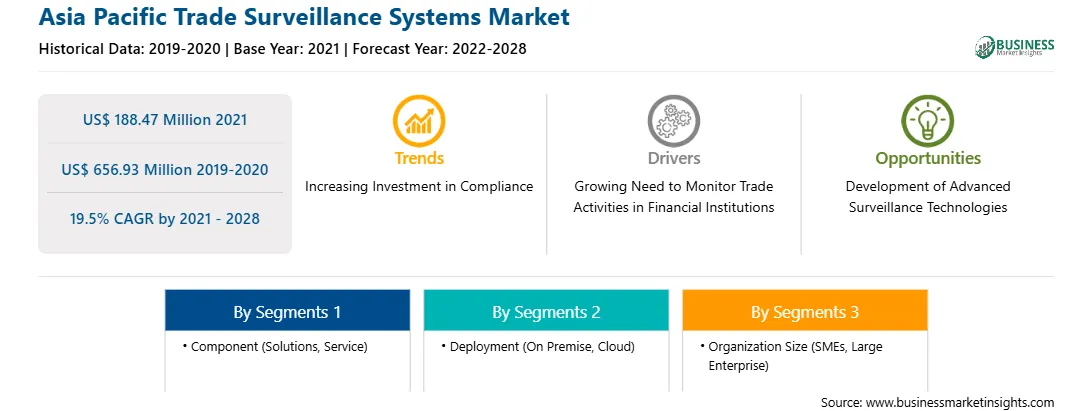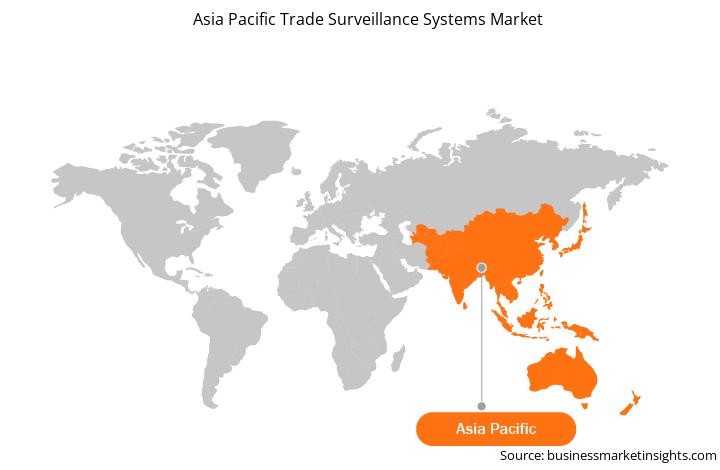Asia Pacific Trade Surveillance Systems Market
No. of Pages: 125 | Report Code: TIPRE00024729 | Category: Technology, Media and Telecommunications
No. of Pages: 125 | Report Code: TIPRE00024729 | Category: Technology, Media and Telecommunications
The Asia Pacific trade surveillance system market is segmented into China, India, Japan, Australia, South Korea, and Rest of Asia Pacific. The region has a presence of both developed and developing countries and have observed a rise in the technological adoption across all markets, such as the financial market. The presence of major manufacturers across the region with their constant investments in business expansion worldwide by listing the shares in prominent stock exchanges is influencing the adoption of trade surveillance systems in Asia Pacific. The Securities and Exchange Board of India (SEBI) is the regulating authority for India's securities and commodity markets, and it is overseen by the Ministry of Finance. In its legislative role, it sets regulations; in its executive role, it conducts investigations and enforcement actions; and in its judicial role, it issues findings and orders. Similarly, China’s security trading market is governed by the China Securities Regulatory Commission (CSRC). The CSRC's responsibilities comprise drafting and enforcing securities laws, approving, and regulating fund management companies, obtaining, and publishing market statistics, and investigating and prosecuting law infractions across the security trading industry in China. Australian securities market is governed by two independent government agencies: the Australian Securities and Investments Commission (ASIC) and the Reserve Bank of Australia (RBA). The establishment of broad international standards for the regulation and conduct of clearing and settlement facilities is the responsibility of the Committee on Payments and Market Infrastructures (CPMI) and the Technical Committee of the International Organization of Securities Commissions (IOSCO). The CPMI-IOSCO Principles for Financial Market Infrastructures lays forth these guidelines. Thus, the high governance from regulatory bodies across all nations and the stringent rules and regulations set by them are contributing to the high adoption of trade surveillance systems in APAC, thereby influencing the growth of the APAC trade surveillance system market.
The COVID-19 pandemic has severely impacted Asia Pacific due to wide disease spread; countries in this region are among the highly populated countries in the world, which leads to the greater risk infection spread. Many global brands and technological companies are headquartered in the region. According to the Organization for Economic Co-operation and Development (OECD), the pandemic has affected major economies such as China, India, Australia, and Japan, which are experiencing inflation. The rapid outbreak of the COVID-19 pandemic has led to strict lockdowns across the region since the starting of 2020. Some part of the region like India are still facing lockdowns owing to the rising cases across the country. The region has been experienced a closure of all business activities in the initial moths of 2020, thereby leading to declining stock prices. This decreasing stock prices across the developing countries, there trading activities experienced a decline across the region. Moreover, owing to lockdown of all business activities and other critical situations, technological investments was also low which negatively impacted the growth of the market. However, with the normalization of economies and business activities the share market experienced a rise which led to more people investing in shares again and technological investments in cloud solutions were experienced across the security trading companies. Thus, the above-mentioned factors are expected to moderately impact the growth of the market over the years.

Strategic insights for the Asia Pacific Trade Surveillance Systems provides data-driven analysis of the industry landscape, including current trends, key players, and regional nuances. These insights offer actionable recommendations, enabling readers to differentiate themselves from competitors by identifying untapped segments or developing unique value propositions. Leveraging data analytics, these insights help industry players anticipate the market shifts, whether investors, manufacturers, or other stakeholders. A future-oriented perspective is essential, helping stakeholders anticipate market shifts and position themselves for long-term success in this dynamic region. Ultimately, effective strategic insights empower readers to make informed decisions that drive profitability and achieve their business objectives within the market.

| Report Attribute | Details |
|---|---|
| Market size in 2021 | US$ 188.47 Million |
| Market Size by 2028 | US$ 656.93 Million |
| Global CAGR (2021 - 2028) | 19.5% |
| Historical Data | 2019-2020 |
| Forecast period | 2022-2028 |
| Segments Covered |
By Component
|
| Regions and Countries Covered | Asia-Pacific
|
| Market leaders and key company profiles |
The geographic scope of the Asia Pacific Trade Surveillance Systems refers to the specific areas in which a business operates and competes. Understanding local distinctions, such as diverse consumer preferences (e.g., demand for specific plug types or battery backup durations), varying economic conditions, and regulatory environments, is crucial for tailoring strategies to specific markets. Businesses can expand their reach by identifying underserved areas or adapting their offerings to meet local demands. A clear market focus allows for more effective resource allocation, targeted marketing campaigns, and better positioning against local competitors, ultimately driving growth in those targeted areas.

The trade surveillance systems market in Asia Pacific is expected to grow from US$ 188.47 million in 2021 to US$ 656.93 million by 2028; it is estimated to grow at a CAGR of 19.5% from 2021 to 2028. There has been an increase in the number of suspicious trading patterns in recent years in terms of a lack of flexible deployment, false positives, and data sources that are not truly integrated as per standard compliance, which would create need for the implementation of an effective trade surveillance system in financial institutions in coming years. Also, to improve the overall investor interface experience and stay ahead in the competitive market landscape, trade surveillance providers are anticipated to increase the number of solutions during the forecast period. In future, financial institutions are expected to invest in the trade surveillance systems with an ability to provide real-time information to the institutions and collect and monitor multiple structured and unstructured data sets simultaneously. Moreover, major market manipulations such as loss of investor confidence, damage to market integrity, fraud behavioral patterning, and insider trading would propel the demand for trading surveillance systems in financial institutes in coming years.
In terms of component, the solution segment accounted for the largest share of the Asia Pacific trade surveillance systems market in 2020. Further In term of solution, the risk and compliance segment held a larger market share of the trade surveillance systems market in 2020. Similarly in term of services, the professional services segment held a larger market share of the trade surveillance systems market in 2020. In terms of deployment, the on premise segment held a larger market share of the trade surveillance systems market in 2020. In term of organization size, large enterprises segment held a larger market share of the trade surveillance systems market in 2020
A few major primary and secondary sources referred to for preparing this report on the trade surveillance systems market in Asia Pacific are company websites, annual reports, financial reports, national government documents, and statistical database, among others. Major companies listed in the report are B-Next; OneMarketData LLC; SIA S.P.A.; CRISIL Limited; FIS Global; Nasdaq Inc; and Software AG among others.
The Asia Pacific Trade Surveillance Systems Market is valued at US$ 188.47 Million in 2021, it is projected to reach US$ 656.93 Million by 2028.
As per our report Asia Pacific Trade Surveillance Systems Market, the market size is valued at US$ 188.47 Million in 2021, projecting it to reach US$ 656.93 Million by 2028. This translates to a CAGR of approximately 19.5% during the forecast period.
The Asia Pacific Trade Surveillance Systems Market report typically cover these key segments-
The historic period, base year, and forecast period can vary slightly depending on the specific market research report. However, for the Asia Pacific Trade Surveillance Systems Market report:
The Asia Pacific Trade Surveillance Systems Market is populated by several key players, each contributing to its growth and innovation. Some of the major players include:
The Asia Pacific Trade Surveillance Systems Market report is valuable for diverse stakeholders, including:
Essentially, anyone involved in or considering involvement in the Asia Pacific Trade Surveillance Systems Market value chain can benefit from the information contained in a comprehensive market report.